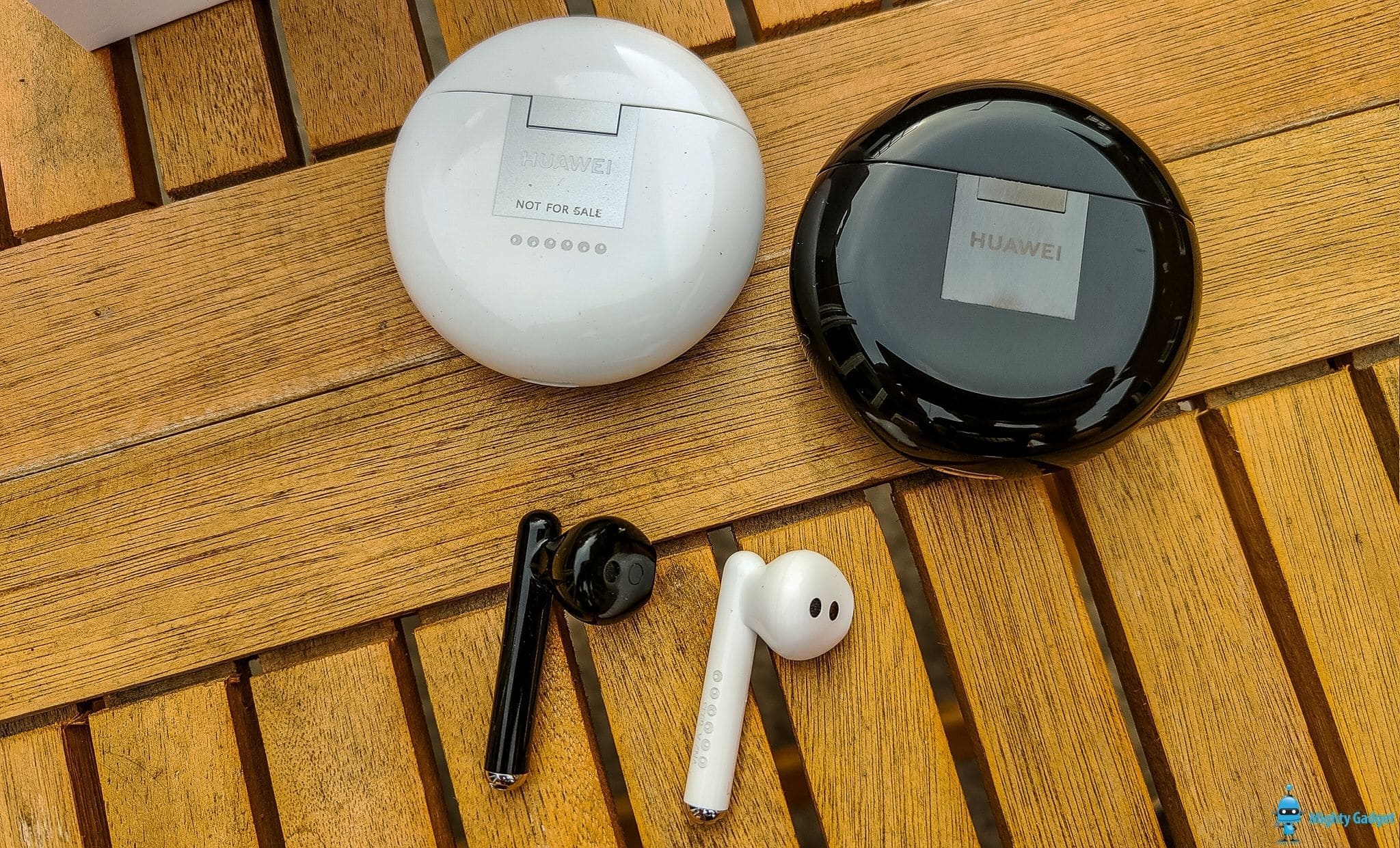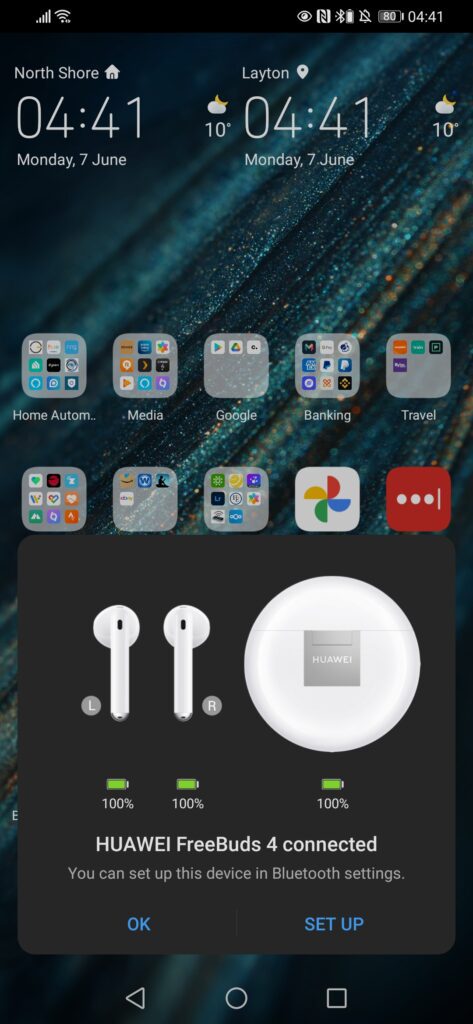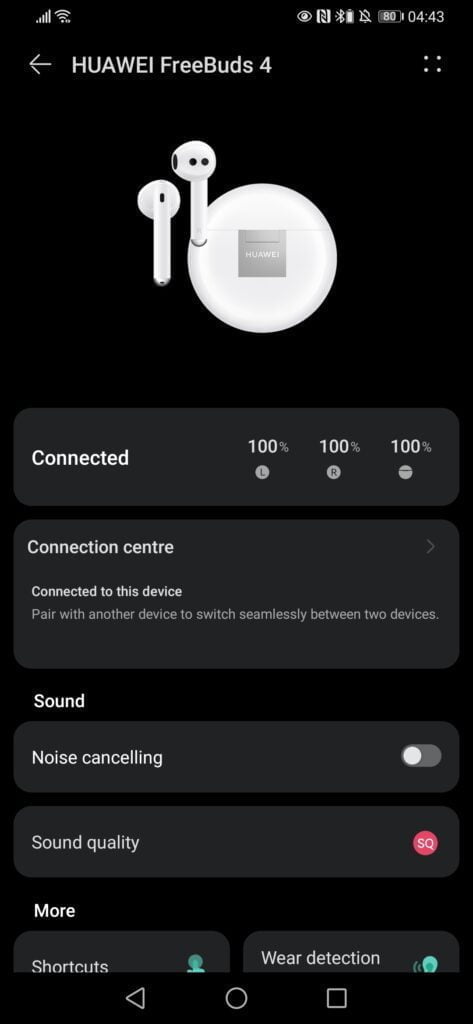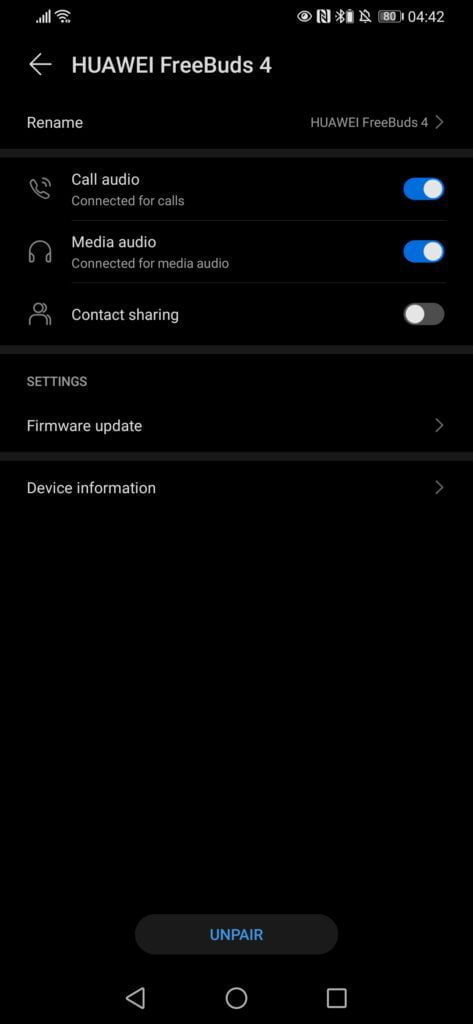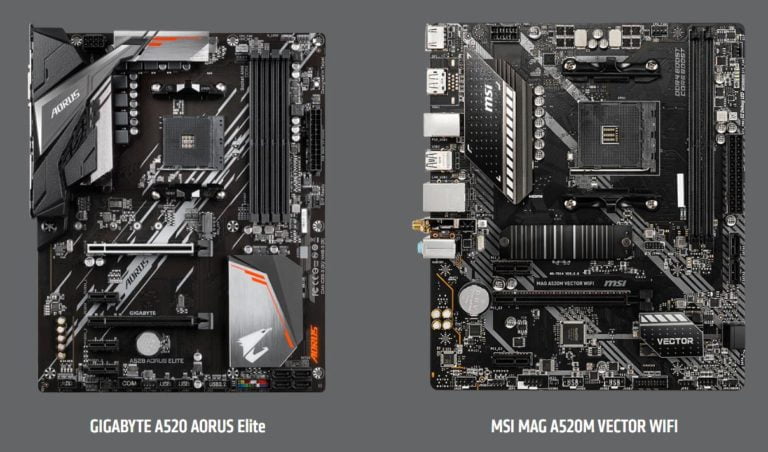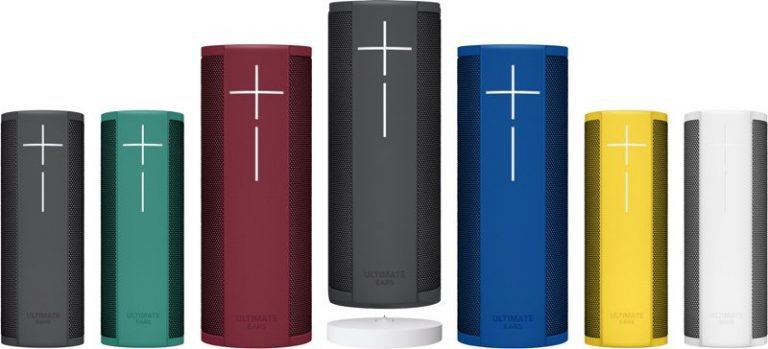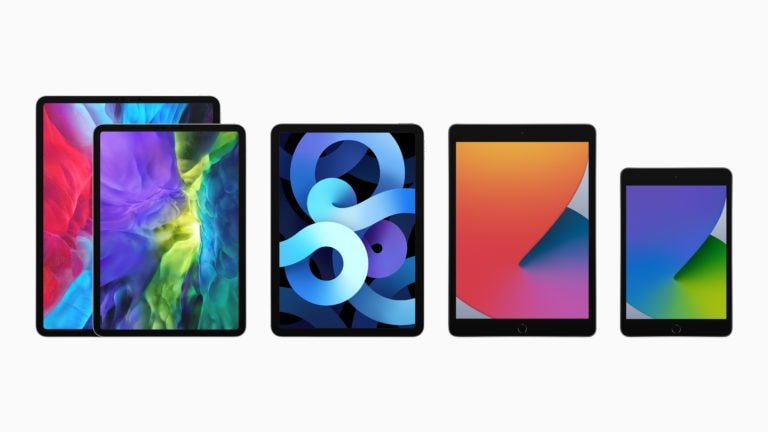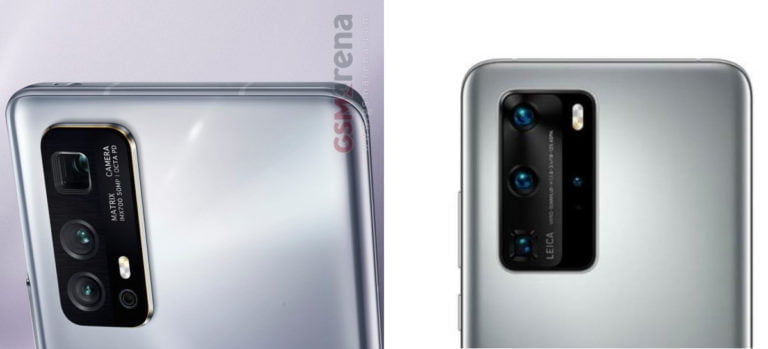Any links to online stores should be assumed to be affiliates. The company or PR agency provides all or most review samples. They have no control over my content, and I provide my honest opinion.
Last week, Huawei announced numerous new products, with the highlight being the Huawei Watch 3 running Harmony OS 2 along with new tablets both running Harmony OS, too.
Huawei also announced their latest FreeBuds, the FreeBuds 4. These follow the same path as the previous FreeBuds 3 with an open-fit design while also incorporating active noise cancelling.
I liked the FreeBuds 3, but have Huawei done much to improve them two years later?
FreeBuds 4 Specification
| Preview | Product | Rating | Price | |
|---|---|---|---|---|

| HUAWEI FreeBuds 4 - Wireless Bluetooth Open-fit Earphones... |
£65.95 | Buy on Amazon |
- Driver: 14.3 mm LCP dynamic driver + bass tube
- Sensors: Wear detection sensor
- ANC: Yes, 25dB
- Connectivity: BT 5.2
- IP Rating: IPX4
- Battery:
- Eurbuds: 4 hours (with ANC disabled) or 2.5 hours (with ANC enabled)
- With Case: 22 hours (with ANC disabled)
- Dimensions: 41.4mm (h) x 16.8 mm (w) x 18.5 mm (d)
- Weight: 4.1g
Huawei FreeBuds 4 vs FreeBuds 3
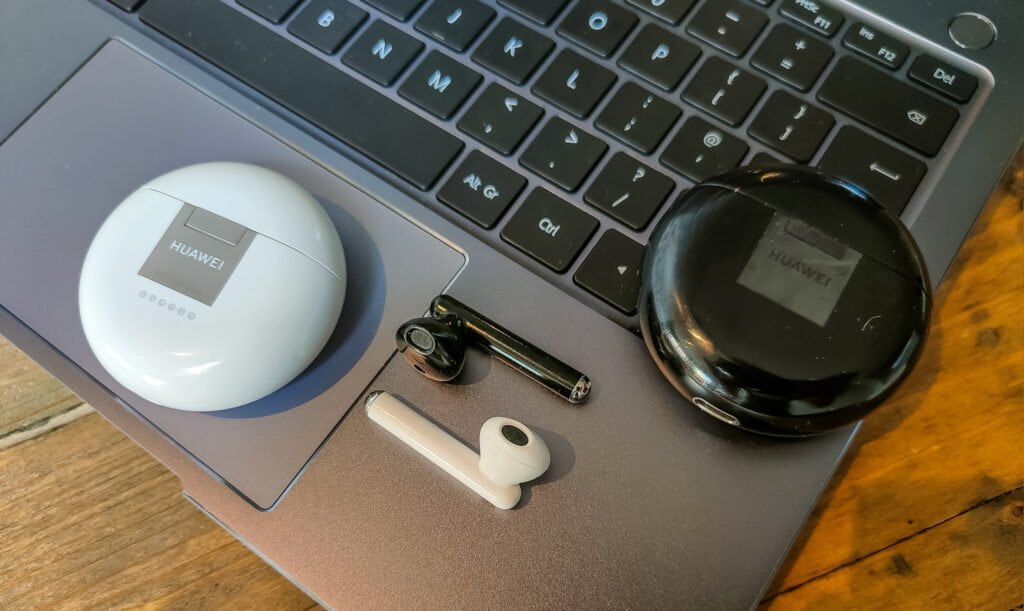
There is not a significant change since the previous generation, but there is a number of tweaks that add up and should make these better, at least on paper:
- The Freebuds 4 now have a 14.3 mm LCP dynamic driver vs 14 mm dynamic driver (or 14.2mm depending if you read the main features page, or the spec page. Both have a bass tube. No specific statements about sound quality improvement
- The Freebuds 4 offer superior active noise cancelling
- The earphones themselves seem to have the same battery, but Huawei states the Freebuds 4 offer 22 hours of music playback with the charging case vs 20. However, the mAh of the case is the same 410 mAh (minimum)
- The Freebuds 4 have been upgraded to BT 5.2
- Now officially IPX4 rated
- Reduced weight from 4.5g down to 4.1g
- While you couldn’t tell, the dimensions are different:
- FreeBuds 3: 41.5mm (h) x 20.4 mm (w) x 17.8 mm (d)
- FreeBuds 4: 41.4mm (h) x 16.8 mm (w) x 18.5 mm (d)
Design & Fit
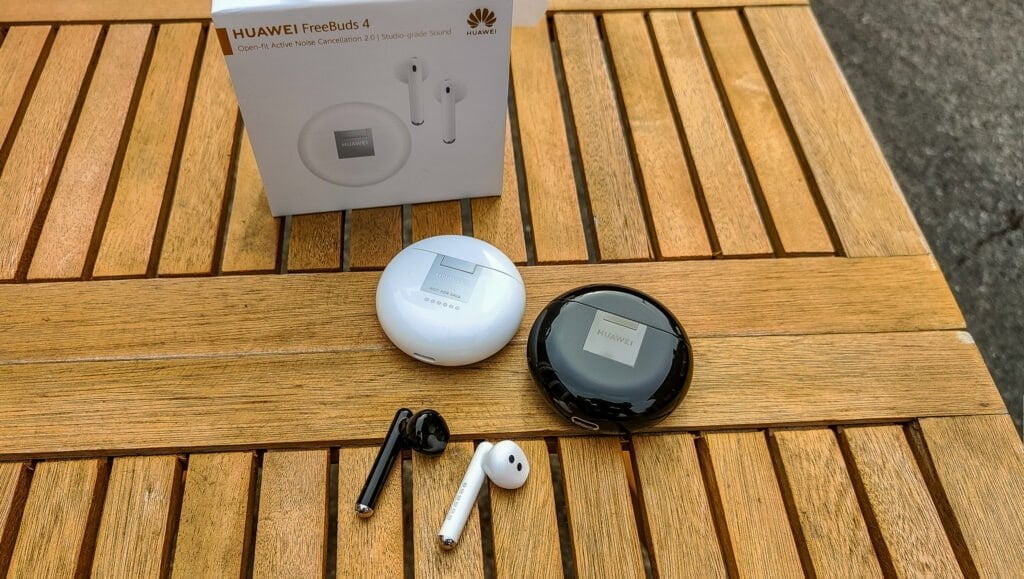
While the Freebuds 4 have slightly different dimensions than the Freebuds 3, you could not tell.
I am not personally a fan of the open fit design, my ears are too big, and I don’t like the unsecure loose feeling. However, my partner won’t use anything other than Air Pods due to that design. Each to their own, but it is something you need to consider before buying these.
While it is not my favourite design, they do stay in my ears, as long as I don’t do any vigorous exercise. I will admit once you get used to the design, and there is something quite pleasant about openness and situational awareness they offer.
Previously, with the Freebuds 3, I bought silicone ear tips designed for the Air Pods, I can confirm these still fit without issue, but I actually found I preferred the sound without them on.
Huawei Phones vs Other Android Phones – Set Up & Settings
The FreeBuds 4 work brilliantly on any Android phone, but you will need the AI Life app to make the most of them. The AI Life app is available on the Apple App Store too, so these should work well on the iPhone, assuming Huawei has added the FreeBuds 4 to the app.
However, there is a different user experience when using a Huawei phone, it is just a bit more seamless.
Using my old Huawei P30 Pro, the phone automatically identified the FreeBuds with pop up and pair then offering set up settings. Within the Bluetooth setting, I can also upgrade the firmware.
There are no codec options with Huawei devices, it just does whatever Huawei does. I am not even sure what the specific codec is when using a Huawei phone. They just make claims of high-resolution sound with ultra-low latency.
On my Oppo Find X3 Neo, I have the choice between SBC as default, or you can toggle to AAC.
AI Life App
At the time of writing, the AI Life only works with the FreeBuds 4 with my Huawei P30 Pro. This is almost certainly because it has not officially launched yet, and I think that phone is running a version of AI Life that was previously sent over by the PR department. AI Life on my P40 Pro was unable to add the FreeBuds 4.
Sound Quality
The sound quality is excellent. Though, you do get a different sound profile silicon tipped earbuds. The design benefits by giving you an airiness feeling to the sound but it also reduces the low-end emphasis created by a passive seal. Huawei has countered this weakness by including a bass tube that offers a pleasant amount of bass while not suffering from the boominess you can get with a passive seal.
I managed to find my old FreeBuds 3 at the bottom of a drawer, so I spent some time switching between the two.
I am not very good at describing sound, but there seems to be a better balance across ranges.
Listing to K.Flay – TGIF switching from the Freebuds 4 to the Freebuds 3, there is a noticeable increase in harshness with the mids and highs. The Freebuds 4 also seem to handle bass a little better.
Switching to Ju$T by Run the Jewels, the low-end differences were harder to tell apart, they sound different, but I wouldn’t say that the Freebuds 4 are more pronounced or significantly improved. They both sound great (considering the open nature).
Overall, the Freebuds 3 sounded good in the first place, the FreeBuds 4 sound better. It is a subtle but noticeable improvement.
Noise Cancelling
An open-fit design and active noise cancelling are two concepts that work against each other. It was a strange inclusion with the FreeBuds 3, but it did work. The ANC was subtle, you could tune it to handle different scenarios better, and it would cut out some of the drone from the surrounding noise.
Huawei has a tendency to show off their noise-cancelling performance in the form of numbers. While I am not sure if the numbers can be believed when comparing between brands, they seem to be accurate when comparing across Huawei products. The FreeBuds Pro are rated at 40 dB.
With the FreeBuds 3 and 4, they seem to be less confident about their numbers. The Freebuds 4 launched in China with claims of 25db noise reduction, but I can see no such claims on the global press release or the UK website.
Instead, they state:
The new Open-fit ANC 2.0 technology has improved noise cancellation at the hardware and software level, taking open-fit, comfortable noise cancellation to new levels.
When I reviewed the FreeBuds 3, I could find no claims about ANC, but now the product page states quite a low 15 dB.
In the footnotes on the Huawei website, it states:
The data is from HUAWEI test lab and uses multiple participants to determine the average noise reduction level in the range of 100 Hz-2000 Hz. Actual performance may vary due to differences in ear and wearing conditions.
Which makes it sound like the ANC figures stated are derived from the subjective opinion of users. Which I guess makes sense, especially with the open fit design affecting the performance based on ear shape.
But, it means that any numbers Huawei claim can not be compared to what others claim. Many brands such as Sony and Bose make no specific ANC claims. Instead, they make grand, often ambiguous statements about the performance.
Based on my personal usage, I would agree that the FreeBuds 4 perform somewhere in the middle between the FreeBuds 3 and Pro. Considering the open fit, it is actually quite impressive. Using my standard Airplane Cabin White Noise video on YouTube, there is a significant drop in low-end hum. Quite a lot more than the FreeBuds 3, and there was no tweaking of the ANC required.
Microphone
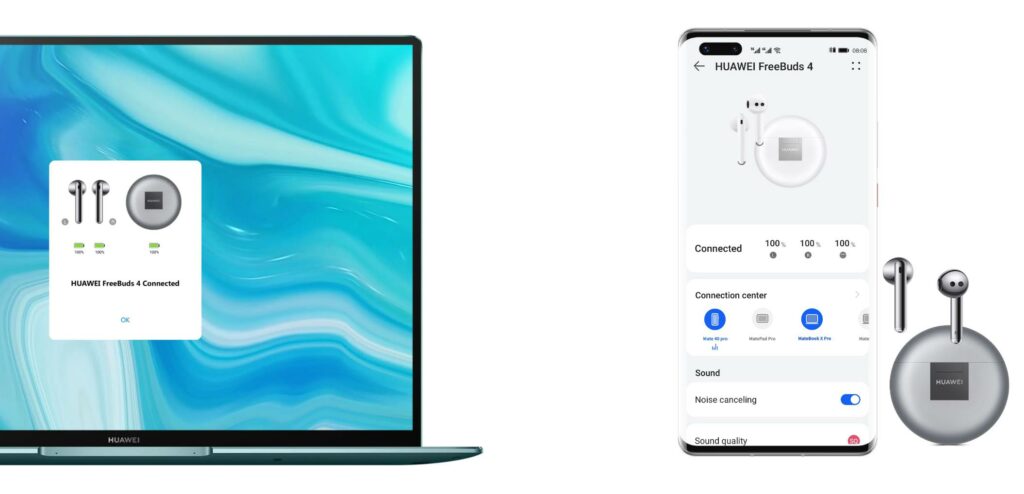
I rarely use my for actual phone calls, so my real-life testing of the microphone has been somewhat limited.
If you are all in with Huawei, then these will seamlessly transition between devices, so I have actually used them for Zoom calls on my Huawei Matebook 13, and in this scenario, they worked perfectly.
Battery
Battery life is OK. We have seen many brands significantly increase the longevity of their earphone battery in the past year or two. So, while these offer about the same performance as the FreeBuds 3, I think comparatively to the rest of the market, the 4 hours with no ANC is starting to look a little low. With ANC on, you get just 2.5 hours.
I haven’t found the battery life to be a problem yet, but as the world opens up and I start to travel more, it is quite feasible that I will wear earphones for several hours at a time (getting to London will take me over 4 hours).
Price and Alternative Options
The Huawei FreeBuds 4 have two options, one with wireless charging and one with wired charging only. Amazon currently has them priced at £140.27 and £129.99, respectively.
This is a significant drop in price compared to the £169.99 launch price of the FreeBuds 3. However, the current price of them is just £77.
The Huawei FreeBuds Pro currently sit at £117. I still use these, and I love them, they are a great buy at this price, and they are the option to go for if you prefer the silicon tipped design that creates a passive seal.
The Apple AirPods are priced at £121.43 and £156.00 for the wired and wireless models and I suspect this is why the FreeBuds 4 have launched at that price.
Overall
Even though open fit earphones are not my preferred design, the Huawei FreeBuds 4 are excellent.
Sound quality is superb, the open fit design creates a different sound profile than I am used to, there is more airiness to it, but the earphones still manage to produce pleasantly low bass.
The active noise cancelling has been significantly improved compared to the previous generation, but the lack of passive isolation you get from silicon tips means these can’t compete with the FreeBuds Pro.
Huawei has priced these wisely, undercutting Apple and lowering the RRP from the previous generation. I have not used these with an iPhone but the lower price point and added ANC could make them a tempting alternative to the Air Pods.
Huawei FreeBuds 4 Review
Summary
The Huawei FreeBuds 4 take the already good FreeBuds 3 and make them a bit better. The significant difference is the improved ANC, it is not market-leading performance, but considering the RRP and open fit, it is very impressive.
Overall
80%-
Overall - 80%80%
Pros
- Significantly improved ANC vs FreeBuds 3
- Slightly improved audio
- An excellent alternative to AirPods if the open fit design is your preference
Cons
- Battery life is starting to look short vs other recent earphones
- Open fit design is not for everyone
I am James, a UK-based tech enthusiast and the Editor and Owner of Mighty Gadget, which I’ve proudly run since 2007. Passionate about all things technology, my expertise spans from computers and networking to mobile, wearables, and smart home devices.
As a fitness fanatic who loves running and cycling, I also have a keen interest in fitness-related technology, and I take every opportunity to cover this niche on my blog. My diverse interests allow me to bring a unique perspective to tech blogging, merging lifestyle, fitness, and the latest tech trends.
In my academic pursuits, I earned a BSc in Information Systems Design from UCLAN, before advancing my learning with a Master’s Degree in Computing. This advanced study also included Cisco CCNA accreditation, further demonstrating my commitment to understanding and staying ahead of the technology curve.
I’m proud to share that Vuelio has consistently ranked Mighty Gadget as one of the top technology blogs in the UK. With my dedication to technology and drive to share my insights, I aim to continue providing my readers with engaging and informative content.
Last update on 2025-07-06 / Affiliate links / Images from Amazon Product Advertising API

